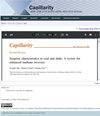Impact of salinity and temperature variations on relative permeability and residual oil saturation in neutral-wet sandstone
Q1 Physics and Astronomy
引用次数: 3
Abstract
: Low-salinity water flooding has become one of the major emerging enhanced oil recovery techniques where lower salinity water is flooded into a hydrocarbon reservoir in order to increase oil recovery. It’s been widely reported that reservoir wettability alteration from oil-wet to water-wet in a low-salinity water process improves oil recovery. Many factors control system wettability, however, role and intensity of each factor is not completely understood. Therefore, several reported affecting factors on wettability alteration were eliminated in the present work in order to determine the impact of different low-salinity water on oil and water relative permeability curves and residual oil saturation. A series of experiments were performed where three simulated brine solutions were injected into oil saturated thoroughly cleaned neutral-wet sandstone core plugs. The effect of injected brine temperature on oil and water relative permeability curves and residual oil saturation was also determined by injecting 115,000 ppm salinity brine at three different temperatures. Results indicate that decreasing flooded water salinity alters the wettability preference of the rock towards favorable water-wetting conditions. Water-wet conditions decrease water mobility and enhance oil mobilization leading to better oil microscopic displacement efficiency and reduced residual oil saturation. Elevated temperature reduces water relative permeability and residual oil saturation.盐度和温度变化对中性湿砂岩相对渗透率和剩余油饱和度的影响
低矿化度水驱已成为新兴的主要提高采收率技术之一,将低矿化度水注入油气储层以提高采收率。在低矿化度含水过程中,储层润湿性由油湿型转变为水湿型,提高了采收率。控制体系润湿性的因素很多,但各因素的作用和强弱尚不完全清楚。因此,为了确定不同低矿化度水对油水相对渗透率曲线和剩余油饱和度的影响,本文对已有报道的影响润湿性变化的几个因素进行了剔除。研究人员进行了一系列实验,将三种模拟盐水溶液注入饱和油、彻底清洗过的中湿砂岩岩心塞中。通过在3种不同温度下注入11.5万ppm盐度的盐水,确定了注入盐水温度对油水相对渗透率曲线和剩余油饱和度的影响。结果表明,降低淹水矿化度改变了岩石的润湿性偏好,有利于润湿性条件。水湿条件降低了水的流动性,增强了油的动员,从而提高了油的微观驱替效率,降低了剩余油饱和度。温度升高会降低水的相对渗透率和剩余油饱和度。
本文章由计算机程序翻译,如有差异,请以英文原文为准。
求助全文
约1分钟内获得全文
求助全文
来源期刊

Capillarity
Physics and Astronomy-Surfaces and Interfaces
CiteScore
7.10
自引率
0.00%
发文量
15
审稿时长
2~3 weeks
期刊介绍:
Capillarity publishes high-quality original research articles and current reviews on fundamental scientific principles and innovations of capillarity in physics, chemistry, biology, environmental science and related emerging fields. All advances in theoretical, numerical and experimental approaches to capillarity in capillary tube and interface dominated structure and system area are welcome.
The following topics are within (but not limited to) the scope of capillarity:
i) Capillary-driven phenomenon in natural/artificial tubes, porous and nanoporous materials
ii) Fundamental mechanisms of capillarity aided by theory and experiments
iii) Spontaneous imbibition, adsorption, wicking and related applications of capillarity in hydrocarbon production, chemical process and biological sciences
iv) Static and dynamic interfacial processes, surfactants, wettability, film and colloids
v) New approaches and technologies on capillarity
Capillarity is a quarterly open access journal and free to read for all. The journal provides a communicate platform for researchers who are interested in all fields of capillary phenomenon.
 求助内容:
求助内容: 应助结果提醒方式:
应助结果提醒方式:


